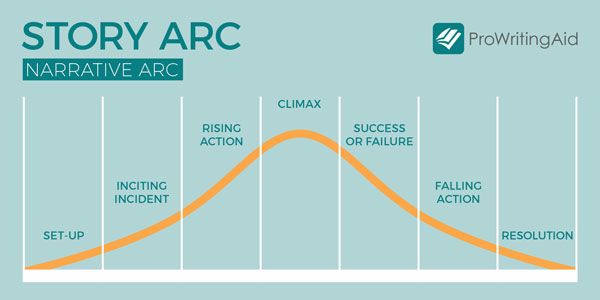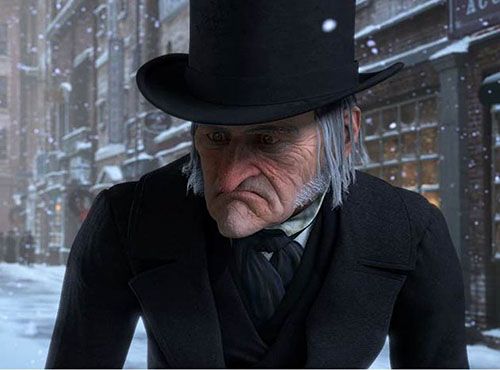The Story Arc

Jack and Jill went up the hill to fetch a pail of water; Jack fell down and broke his crown and Jill came tumbling after. Up Jack got and home did trot as fast as he could caper; went to bed to mend his head with vinegar and brown paper. Jill came in and she did grin to see his paper plaster; Mother, vex'd, did whip her next for causing Jack's disaster.

Universal to both fiction and nonfiction, the Story Arc (or Narrative Arc) refers to the structure, shape and overall layout of a story. This arc is made up of the sequence of events in your plot, the peaks and valleys that set the pace, how it is broken up into chapters and scenes, what events make up the conflict and climax, and what occurs in the final resolution. Basically, your story needs to start somewhere, go somewhere, and end somewhere. We hope this article helps you chart that course.

Outlining your story arc and how it relates to the plot
When outlining the story arc, you will follow the same basic structure as a plot outline. Plot refers to the specific events (or parts) that make up your story. We talk about these events in the chapter titled Plot Parts in this guide. When outlining a plot, most writers follow a trusted format (or map), such as Freytag's Pyramid, which can be found in the chapter titled Outlining Your Plot...or Not, also found in this guide.
Graphing your story on paper can help identify your story arc, ensuring that the action rises, falls a little, rises even more, falls a slight bit, and keeps rising until reaching the climax. You might end up with something that looks like a bell curve, or it might look like a stock market index. Either way, your action should consistently raise the stakes until it reaches the peak.



The story arc blueprint
When outlining your story arc, it's easier to have a blueprint; a summary of each aspect of your novel. The '5 W's' (who, what, why, where and when) are the basic building blocks of stories. Think about how each might change and impact your story arc and ask yourself these questions:
◾How will the cast of my story (the 'who') grow or diminish? In what ways will central or secondary characters create tension, plot complications, or emotional impact?
◾What new character motivations or external forces (the 'why') will affect the course of the story arc? Could a misguided motivation lead to a fall for a character? Could this lead to enlightenment and, ultimately, to change?
◾How will the setting of your story change (the 'when' and 'where') and what could this add to the story arc? For example, your character could relocate to a more difficult setting as a result of increasing drama (e.g. shifting to a courtroom setting in a crime-thriller)
◾The plot is the foundation of a story and is often referred to as (the 'what'). This should remain fairly constant. The themes and subject matter of your novel need to have some relation to each other for your story to feel cohesive.

How the story arc relates to character arcs
Your story arc and character arc should be melded together in such a way you're not sure where one begins and the other ends. Your main character must be confronted with danger, threats, seduction, tests of bravery, moral dilemmas, physical or emotional assaults, just to name a few. As your main character struggles and overcomes obstacles throughout the story arc, they naturally change by the resolution. Simply put, a well-executed story arc must also include a character arc.

Create smaller arcs within your primary story arc
Similar in theory to subplots, creating smaller arcs within your main narrative arc has multiple benefits. Dramatic structure often doesn't unfold in one single, grand arc. Smaller sequences of rising and falling action within the larger story develop characters, tease out central themes, and provide additional stakes. Series in particular, combine multiple arcs in order to sustain interest and tension within a grander, overarching story arc.

The importance of the climax within a story arc
The climax represents the moment when the story arc bends and begins its descent. When it comes to the story arc, the placement of a climax typically occurs around 90% of the way through the narrative in order to have the greatest impact. On a graph, this will make your 'bell curve' a bit lopsided, but that's okay. Once the climactic moment happens, the story should be resolved quickly. If the climax happens too soon, the resolution will be too long, and readers will become disengaged. If a writer places the climax too late in the story without a proper wrap-up, it creates an unsatisfying conclusion.

A chat about series arcs
A series arc is the trajectory of your overall story from the first book to the last. Think of it in terms of a TV show, where each book in your series is like a season, from the pilot to the finale. A solid plan at the start will make every season feel like part of the unified whole.
That said, this can be done with a loose outline. Think of how each entry in your series builds towards your finale. It's often useful to start with the ending. Yes, the ending of your entire series. You don't need to write it in great detail. It could be as simple as 'The hero vanquishes the villain, or 'The protagonist sacrifices herself to save the world'. That way, you have an idea of what your series finale will be.
For example: In J.K. Rowling's Harry Potter series, the overall arc is about destroying the horcruxes (magical objects that hold pieces of Lord Voldemort's soul), and ultimately destroying Lord Voldemort. Each volume in that series advances that arc.

7 Common Story Arcs
👹 Overcoming the Monster: The main character must stop the person or force threatening them. Example: Dracula by Bram Stoker.
💲 Rags to Riches: The main character begins poor, comes into money (and/or fame, power, and love), loses it, and becomes a better person because of it. Example: Great Expectations by Charles Dickens.
🗻 The Quest: The main character takes an epic journey to find something, someone, or some place, running into obstacles on the way. Example: The Lord of the Rings by J.R.R. Tolkien.
🚢 Voyage and Return: The main character visits a new world and returns home with a new perspective. Example: Alice in Wonderland by Lewis Carroll.
🤣 Comedy: The main character experiences an escalating sequence of confusing but comedic events, which are ultimately resolved into a happy ending. Example: A Midsummer Night's Dream by Shakespeare.
😭 Tragedy: The main character has a flaw or makes a mistake that results in their downfall. Example: Romeo and Juliet by Shakespeare.
👶 Rebirth: The main character experiences an event that makes them a better person. Example: A Christmas Carol by Charles Dickens.
👇 👇 👇
A Story Arc Case Study: A Christmas Carol by Charles Dickens
Exposition: We meet Ebenezer Scrooge in Victorian England. We see his cold character traits in action as he shuts out poor men seeking money for food. In the inciting incident, Scrooge is visited by the ghost of Jacob Marley, his late business partner, who warns him he'll be visited by three spirits and that he should take their advice.

Rising action: The Ghost of Christmas Past takes Scrooge back to his unhappy childhood and shows him that his former fiancée, Belle, ended their relationship because he was too obsessed with money. Then the Ghost of Christmas Present takes him to his employee Bob Cratchit's bleak Christmas dinner, where Scrooge learns his son, Tiny Tim, is gravely ill and in danger of dying unless his family's circumstances change.

Climax: The Ghost of Christmas Yet to Come shows Scrooge a future where he dies and nobody mourns his loss. Scrooge breaks down and promises to become a better person if given the chance to go back to the present.

Falling action: Scrooge wakes up on Christmas morning a changed man. To make amends for his poor behavior, he donates money to charity, provides Christmas dinner for the Cratchit family, and gives Bob a generous raise.

Resolution: Scrooge vows to embody the Christmas spirit year-round in all things he does.
Bạn đang đọc truyện trên: AzTruyen.Top